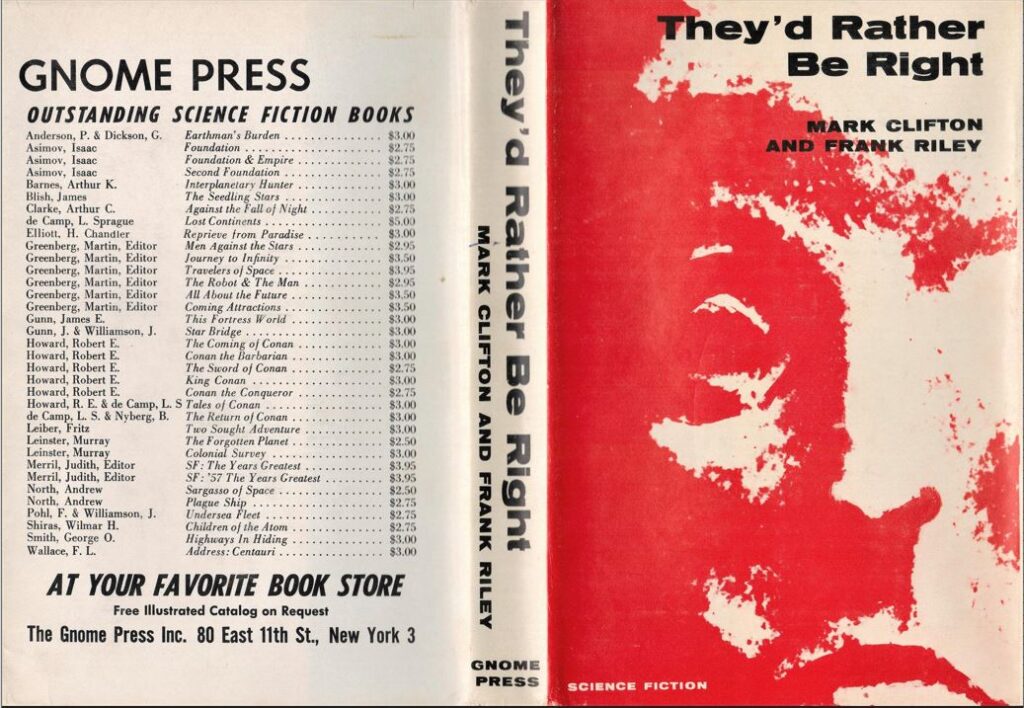Comments
In a field full of teenage prodigies, Mark Clifton (1906-1963) stands out by publishing his first story at the age of 46 after retiring from a career as an industrial psychologist. Perhaps all that preparation was helpful. He started at the top with stories almost simultaneously in Astounding and Galaxy in 1952. Astounding was his natural home, though; he apparently believed in psi powers as fervently as Astounding editor John Campbell.
Two stories for Astounding, “Crazy Joey,” (August 1953), about a young telepath, and “Hide! Hide! Witch!” (December 1953), with an older Joe helping a Dr. Billings to invent a logical supercomputer, Bossy, were written with Alex Apostolides, who wrote five stories with Clifton that year and only one alone thereafter. The second story ends with Bossy being dismantled to calm the fears of stupid humanity.
Clifton kept the series going, though, with a new partner, Frank Riley (1915-1996). The Forever Machine appeared as a four-part serial in Astounding in 1954. Riley, who also had not published any sf before working with Clifton, was the pen name for Frank Wilbert Rhylick, a Los Angeles journalist. He wrote only about another half dozen sf stories on his own and has no identity in the field except for this one story.
They’d Rather Be Right is perhaps the purest distilled essence of Campbellian 1950s agitprop, as stifling as that of the Communists. In its future, government bureaucracy is near-Orwellian in allowing only approved thoughts and speech. Bossy is a mind that works off of pure facts and can convey that power to humans who are able to free themselves of old ways of thinking, giving them eternal youth and telepathy to boot, themes obviously reminiscent of two more of Campbell pet enthusiasms, General Semantics and Dianetics.
Gnome Notes
The trifecta of pseudoscience thrilled 50s’ readers; fans gifted the serial with the Hugo Award for Best Novel in 1955. Since Marty Greenberg practically had a pneumatic tube to Campbell’s office the only surprise is that it took him until 1957 to publish it in book form. (It was rewritten from the magazine version, admittedly.) The self-righteous title was changed the next year to The Forever Machine, when an abridged version of the novel was published by, of all people, Campbell’s rival Horace Gold as a paperback Galaxy Novel. The paperback’s debt to Gnome is obvious. The back-cover blurb is the flap copy from Gnome lightly rewritten. Another reason to consider the van der Poel connection. W. I. van der Poel was the art director for Galaxy and became the uncredited art director for Gnome at around this time. A flow of Gnome material to Galaxy Novels followed.
Reaction to the novel since the 50s has not been so kind. Right was often held up as the single worst book to be voted Best Novel, although it’s so forgotten and unread today that newer books have superseded it. There was no shortlist issued in 1955 so we don’t know what the other candidates were, but 1954 saw the publication of Isaac Asimov’s The Caves of Steel, Fredric Brown’s Martians, Go Home, Hal Clement’s Mission of Gravity, Richard Matheson’s I Am Legend, Edgar Pangborn’s A Mirror for Observers, and Gnome’s own The Forgotten Planet by Murray Leinster.
Given the paucity of f&sf awards in the early 1950s, Greenberg’s publishing of three award winners – City won the International Fantasy Award and Colonial Survey included a Hugo-winning novelette – is a remarkable accomplishment.
Reviews
Floyd C. Gale, Galaxy Science Fiction, August 1958
Although a passably workmanlike job, loose ends outnumber neat knits in this yarn.
Anthony Boucher, The Magazine of Fantasy & Science Fiction, April 1958
[O]ne might well protest the credulous machinolatry of Messrs. Clifton and Riley – almost as much as their inability to keep a story moving.
Contents and original publication
• Chapters 1-27 (rewritten from Astounding Science Fiction, August, September, October, and November 1954).
Bibliographic information
They’d Rather Be Right, by Mark Clifton and Frank Riley (pseud. of Frank Rhylick), 1957, copyright registration date 25Oct57, Library of Congress catalog card no. 57-14670, title #67, back panels #34, 189 pages, $3.00. 5000 copies printed, 2065 remaindered. Hardback, black boards, spine lettered in blue-green. Jacket design by W. I. Van der Poel. “First Edition” on copyright page. Printed in the U.S.A. by H. Wolff, New York. Back panel: 35 titles.Gnome Press address given as 80 East 11th St., New York 3.
Variants
None known.
Images






